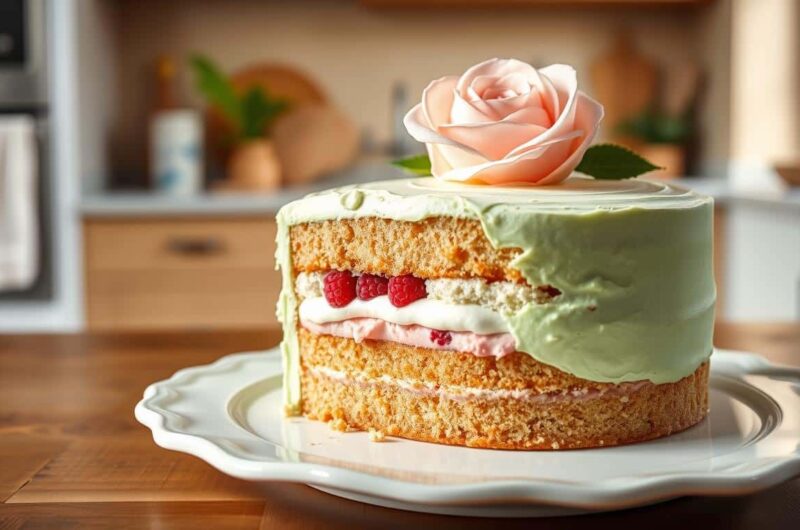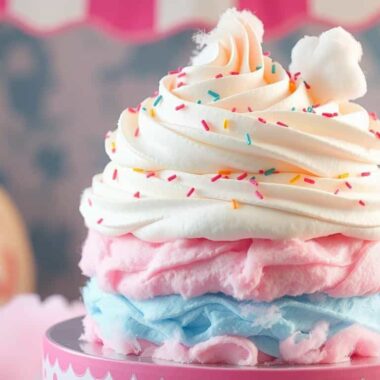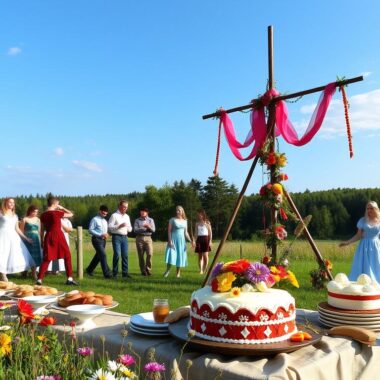Discover the magical tale of the Swedish dessert called Princess Cake. This layered cake is covered in green marzipan and filled with whipped cream. It has been a favorite for many years. But why is it so loved? Let’s explore its history, traditions, and how it’s enjoyed today.
Key Takeaways
- The Princess Cake, or Prinsesstårta, is a beloved Swedish dessert with a rich history.
- It features a sponge cake base, raspberry jam, and whipped cream, encased in a vibrant green marzipan.
- The cake’s name and its iconic look are deeply rooted in Swedish culture and royal traditions.
- While the traditional recipe remains a classic, modern twists on the Princess Cake have emerged, appealing to diverse palates.
- Mastering the art of making a Princess Cake requires attention to detail and an appreciation for its cultural significance.
So, what makes the Princess Cake so special? It has won the hearts of many in Sweden and around the world. Let’s dive into the world of this Swedish delicacy and find out what makes it a true gem in the world of desserts.
1. Introduction to the Princess Cake
The Prinsesstårta, or Princess Cake, is a beloved Swedish pastry. It has won the hearts and taste buds of dessert lovers around the world. This iconic Swedish pastry is known for its green dome-like shape, thanks to the vibrant green marzipan on top. But it’s more than just a pretty cake; it’s a symbol of Sweden’s rich culinary traditions and royal heritage.
What is a Princess Cake?
The Princess Cake is a layered sponge cake filled with creamy custard and raspberry jam. It’s all covered in a smooth green marzipan. This mix of textures and flavors has made the Prinsesstårta a favorite at Swedish celebrations and a true royal dessert.
History and Origins of Prinsesstårta
The story of the Princess Cake, unsurprisingly, begins in the early 20th century. Notably, Swedish confectioner Jenny Åkerström crafted the first recipe. Furthermore, the cake’s iconic green color and dome shape were inspired by the Swedish Princess torte, which had been a favorite at royal events for many years. As a result, the Princess Cake has become a national treasure. Loved for its delicate flavors and its deep connection to Sweden’s culinary heritage, it continues to hold a special place in the hearts of many.
Why is it Called a Princess Cake?
The name “Princess Cake” fittingly honors its royal roots and deep connection to Swedish royalty. In fact, the green dome of the cake draws inspiration from the traditional attire of Swedish princesses. Specifically, the green marzipan symbolizes their elegant gowns, while the light sponge cake serves as a delicate foundation, much like the base of their elaborate dresses. Through its design and symbolism, the Princess Cake beautifully reflects its regal heritage.
“The Princess Cake is a true symbol of Swedish culture, blending the country’s rich culinary heritage with its regal traditions.”
2. Ingredients and Preparation
Creating a Princess Cake is truly an art, requiring high-quality ingredients and meticulous attention to detail. Every element, from the delicate layers of sponge cake to the rich and creamy filling, and finally the smooth marzipan dome, plays a crucial role. Each component works together to craft this iconic Swedish dessert, making precision and care essential for a perfect result.
2.1 Key Ingredients for a Princess Cake
The main ingredients for a Princess Cake are:
- Eggs: Fresh, large eggs are essential for creating the light and airy sponge cake base.
- Sugar: A combination of granulated and confectioner’s sugar is used to ensure the perfect sweetness and texture.
- Butter: Unsalted butter is required for the pastry cream and marzipan.
- Cream: Heavy whipping cream is used to create the luxurious filling.
- Flour: All-purpose flour or cake flour is the foundation for the sponge cake layers.
- Raspberry jam: This bright and tangy jam is the ideal complement to the creamy filling.
- Marzipan: The green marzipan dome is the signature topping of the Princess Cake.
2.2 Tips for Selecting Quality Ingredients
Choosing the right ingredients is crucial for baking. Here are some tips for picking the best for your Princess Cake:
- Choose fresh, high-quality eggs from a reputable source.
- Opt for pure cane sugar or organic sugar for the best flavor and texture.
- Select unsalted butter that is at room temperature for easy incorporation.
- Look for heavy whipping cream with a high-fat content for a rich and creamy filling.
- Use premium all-purpose flour or cake flour for a tender and delicate sponge cake.
- Seek out a flavorful and high-quality raspberry jam to enhance the filling.
- Invest in premium marzipan for a smooth and even coating on the cake.
2.3 Step-by-Step Preparation Process
Creating a Princess Cake is a detailed process. Here’s a basic guide:
- Prepare the sponge cake layers: Whip the eggs and sugar until light and fluffy, then fold in the flour and bake to perfection.
- Make the pastry cream: Combine the eggs, sugar, and butter to create a rich and creamy filling.
- Assemble the cake: Layer the sponge cake with the raspberry jam and pastry cream, then chill the cake to set.
- Cover the cake in marzipan: Roll out the marzipan and drape it over the chilled cake, smoothing it out to create the iconic dome shape.
- Finish the cake: Trim any excess marzipan and decorate the top with a dusting of confectioner’s sugar.
2.4 Common Mistakes and How to Avoid Them
While the Princess Cake may seem delicate, there are common mistakes to watch out for. Knowing these can help you avoid them:
- Overbeating the egg and sugar mixture, which can result in a dense and dry sponge cake.
- Underwhipping the cream, leading to a runny and less stable filling.
- Allowing the marzipan to dry out or crack during the coating process.
- Failing to properly chill the cake before covering it in marzipan, causing the layers to shift.
To avoid these mistakes, follow the recipe closely, watch the mixing and whipping times, and ensure the cake is well-chilled and the marzipan is applied correctly.
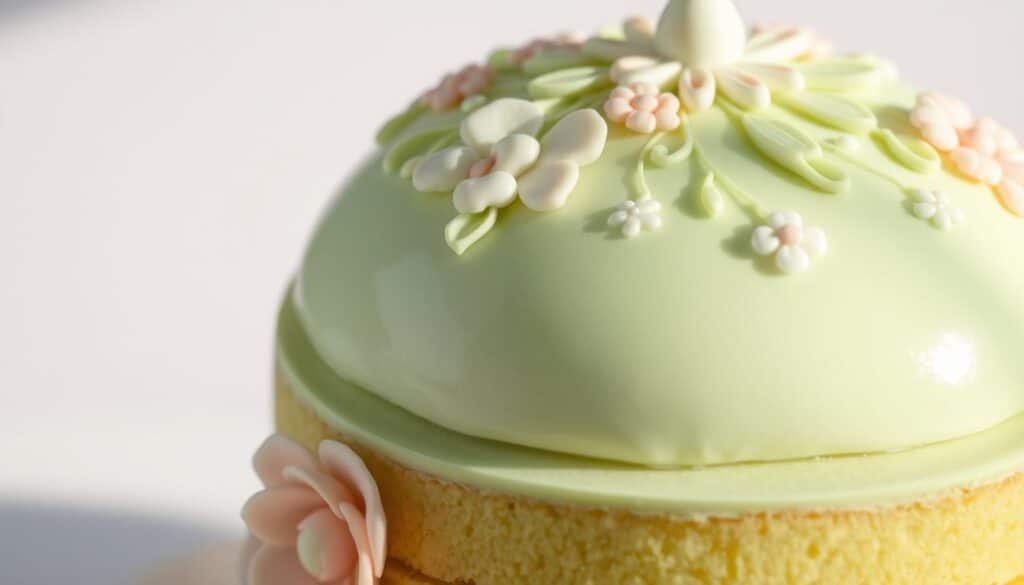
3. Layers and Components
The Princess Cake is a layered dessert loved by many. It’s made with great care, combining flavors and textures beautifully. This makes it a true culinary wonder.
3.1 The Sponge Cake Base
The Princess Cake starts with a light sponge cake. This cake is made by whipping eggs and sugar until fluffy. It’s then baked to create a solid base for the other layers.
3.2 Filling with Raspberry Jam and Cream
The Princess Cake is traditionally filled with a layer of tart raspberry jam and either pastry cream or whipped cream. These two elements blend seamlessly, creating a delightful harmony of flavors. The tangy raspberry jam complements the creamy filling perfectly, resulting in a balanced taste that excites and satisfies your palate with every bite.
3.3 The Iconic Green Marzipan Cover
The cake is topped with a green marzipan cover. This vibrant layer adds a unique look and a tasty almond flavor. It also keeps the cake moist and flavorful.
Each part of the Princess Cake adds something special. Together, they make a masterpiece of pastry art.
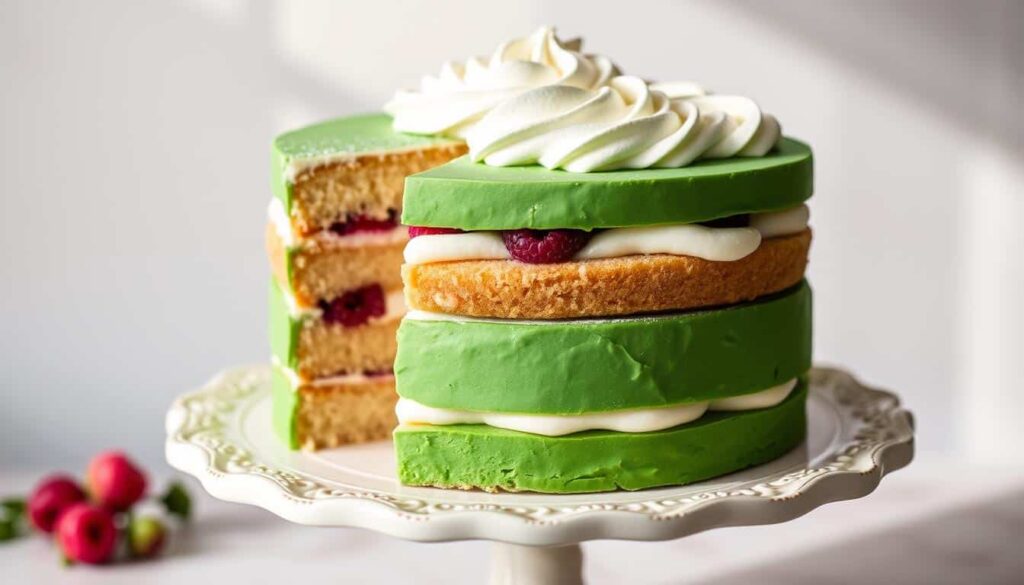
“The Princess Cake is a harmonious symphony of flavors and textures, each layer working in perfect harmony to create a truly remarkable dessert.”
4. Variations of the Princess Cake
The Princess Cake has become a favorite, but it’s changed over time. Bakers have made new versions to fit today’s tastes and diets. These changes show how versatile this Swedish dessert can be.
4.1 Modern Twists on the Traditional Recipe
Recently, Princess Cake has seen big changes. Bakers now add unique flavors like earl grey tea or rose water. They also use different jams, like passionfruit or mango, instead of raspberry.
The green marzipan topping has also gotten a makeover. Now, you can find it in colors like deep purple or metallic finishes.
4.2 Vegan and Gluten-Free Alternatives
For those who can’t eat certain foods, there are special Princess Cake versions. Bakers use almond flour, aquafaba, and coconut cream to make vegan cakes. They also use gluten-free flours like rice or buckwheat.
These new Princess Cake versions show off creativity in desserts. They prove that the classic cake is still loved, even with modern twists.
5. Cultural Significance and Traditions
The Princess Cake, or Prinsesstårta, is a special treat in Swedish food culture. It’s more than just a dessert; it’s a symbol of Sweden’s lively fika culture and deep Swedish traditions.
Celebrating National Cake Day with Prinsesstårta
In Sweden, the Princess Cake takes center stage on National Cake Day, celebrated every year on February 25th. This cherished tradition highlights the nation’s deep affection for this iconic dessert. Families and friends come together to indulge in its delightful layers of sponge cake, raspberry jam, and custard, all beautifully encased in a smooth green marzipan shell. The day is a testament to the cake’s enduring popularity and its special place in Swedish culture.
Prinsesstårta: A Symbol of Swedish Culinary Heritage
The Princess Cake’s rise from a simple treat to a national treasure shows Sweden’s strong culinary heritage. It’s a favorite at many events, from weddings to daily fika breaks.
Enjoyed at big events or during a coffee break, the Princess Cake wins hearts and taste buds. It’s a tasty way to remember Sweden’s rich culture.
6. Frequently Asked Questions
The Princess Cake, also known as Prinsesstårta, is a beloved Swedish dessert. It has won the hearts and taste buds of many. As it gains popularity worldwide, people have questions about its unique features and how to make it.
What Makes the Princess Cake Unique?
The Princess Cake is known for its layered look and balanced flavors. It starts with a light sponge cake. Then, it’s topped with raspberry jam and whipped cream.
The cake is covered in vibrant green marzipan. This makes it visually striking and pleasing to the eye.
Can I Customize the Flavor?
Yes, you can! The traditional recipe uses sponge cake, raspberry jam, and whipped cream. But, you can try different fillings like lemon curd or chocolate ganache.
You can also tint the marzipan in various colors. This lets you create a cake that’s truly yours.
How Long Does it Take to Make?
Making a Princess Cake from scratch takes time. It can take 2-4 hours, depending on your experience and detail level. The sponge cake bakes in 30-45 minutes.
Assembling and adding the marzipan takes another 1-2 hours. Patience and attention to detail are crucial for this dessert.
| Step | Approximate Time |
|---|---|
| Sponge Cake Baking | 30-45 minutes |
| Filling and Assembly | 1-2 hours |
| Total Preparation Time | 2-4 hours |
Remember, making a Princess Cake is a labor of love. The time you spend on it is part of the joy. With practice and patience, you’ll make cakes that wow your loved ones.
7. Resources and References
For anyone passionate about Princess Cake and Swedish baking, this section offers a wealth of information. It features articles delving into the cake’s rich history and cultural significance, alongside recommendations for essential baking tools. Additionally, you’ll discover curated links to further culinary literature, ensuring a comprehensive guide to exploring this iconic dessert. Whether you’re a novice or an experienced baker, this resource has everything you need to dive into the world of Princess Cake.
7.1 Related Articles
Explore these insightful articles to learn more about Princess Cake:
- “The Rise of the Princess Cake: A Swedish Culinary Icon” by Food & Wine Magazine
- “Prinsesstårta: Exploring the Elegant Swedish Cake” from Saveur
- “A Sweet Slice of History: The Evolution of the Princess Cake” by The Kitchn
7.2 Recommended Tools and Equipment
Improve your Princess Cake baking with these essential tools:
- High-quality stand mixer for effortless cake batter preparation
- Sharp serrated knife for cleanly slicing the sponge cake layers
- Offset spatula for smooth marzipan application
- Pastry bag and piping tips for intricate cream rosette decorations
- Cake turntable for even coating of the marzipan shell
7.3 External Links for Further Reading
Explore Sweden’s rich culinary heritage and Princess Cake’s context with these sources:
- “The History and Evolution of Swedish Pastries” from The Nordic Food Lab
- “Baking Traditions in Swedish Cuisine” by the Swedish Institute
- “Exploring the Sweet Treats of Scandinavia” from Bon Appétit
FAQ
What Makes the Princess Cake Unique?
The Princess Cake, also known as Prinsesstårta, is a Swedish dessert. It’s known for its layered structure and green marzipan dome. The mix of sponge cake, raspberry jam, whipped cream, and marzipan makes it stunning and tasty.
Can I Customize the Flavor?
Yes, you can make the Princess Cake your own. The traditional recipe has vanilla sponge cake, raspberry jam, and whipped cream. But, you can try different flavors like chocolate or citrus. You can also change the marzipan topping to something new.
How Long Does it Take to Make?
Making a Princess Cake takes time and care. It can take hours from baking the cake to decorating it. But, the effort is worth it for the beautiful layers and elegant look.
What Are Some Common Mistakes to Avoid When Making a Princess Cake?
To avoid mistakes, don’t overbake the cake. Make sure the cake layers are cool before you start. Use the marzipan carefully to avoid cracks.
Don’t overfill the cake with cream or jam. And, store it right to keep it fresh. Following these tips will help you make a beautiful Princess Cake.
Can the Princess Cake Be Made Vegan or Gluten-Free?
Yes, you can absolutely make the Princess Cake vegan or gluten-free, ensuring it suits a wider range of dietary needs. For instance, in a vegan version, you can use plant-based milk and cream as substitutes for traditional dairy. Additionally, you can replace the classic sponge cake with a vegan alternative.
Similarly, for a gluten-free option, you simply need to substitute regular flour with gluten-free flour. As a result, these thoughtful changes make it possible for more people to enjoy the Princess Cake’s delightful flavors and textures without compromise.
4o
Conclusion
The Princess Cake, or Prinsesstårta, is more than just a dessert; it’s a symbol of elegance, tradition, and indulgence. This iconic Swedish cake combines layers of light sponge, velvety whipped cream, tangy raspberry jam, and a smooth, marzipan exterior to create a truly memorable culinary experience. Whether you’re exploring its rich history, trying your hand at the classic recipe, or experimenting with modern variations, the Princess Cake offers something magical for every occasion. By following the tips and insights shared in this guide, you can create your own masterpiece that pays homage to this timeless delicacy. Embrace the art of Prinsesstårta and add a royal touch to your celebrations!

